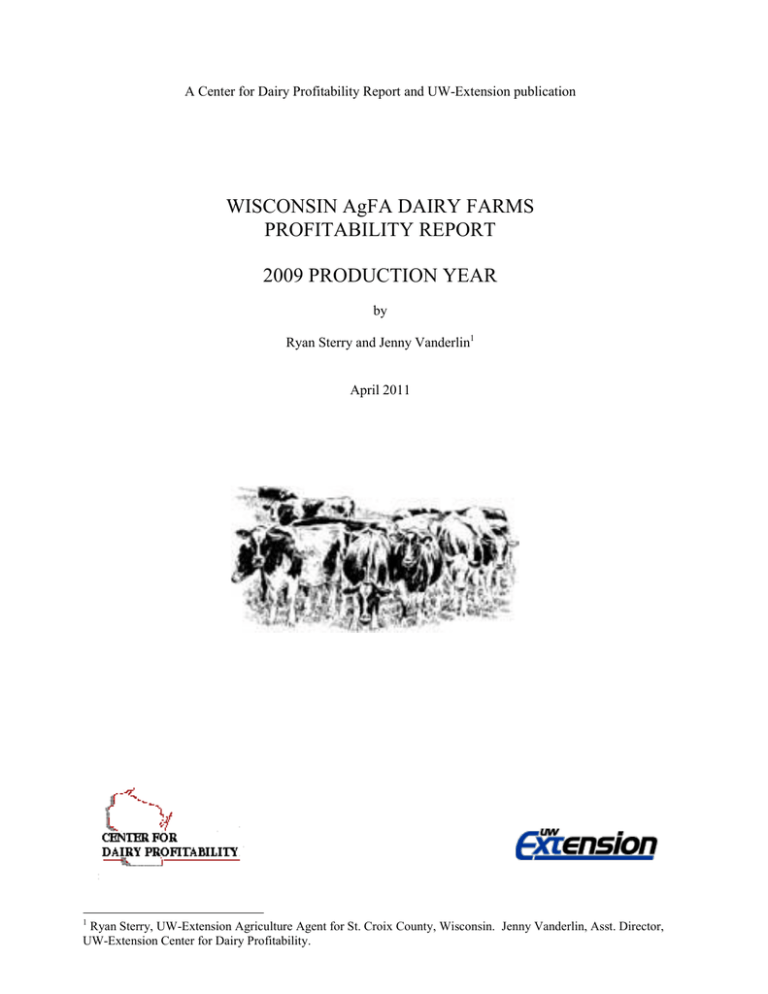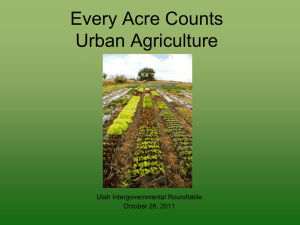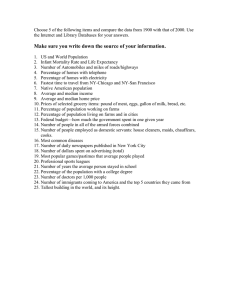WISCONSIN AgFA DAIRY FARMS PROFITABILITY REPORT 2009 PRODUCTION YEAR
advertisement

A Center for Dairy Profitability Report and UW-Extension publication WISCONSIN AgFA DAIRY FARMS PROFITABILITY REPORT 2009 PRODUCTION YEAR by Ryan Sterry and Jenny Vanderlin1 April 2011 1 Ryan Sterry, UW-Extension Agriculture Agent for St. Croix County, Wisconsin. Jenny Vanderlin, Asst. Director, UW-Extension Center for Dairy Profitability. Acknowledgements This report is dedicated to the memory of Lee Milligan for his contributions to the Agriculture Financial Advisor (AgFA©) and Dairy Farm Business Summary programs, and perhaps more importantly his commitment to farm business management education for the producers he served. The authors wish to thank the Lakeshore Farm Management Association, Fox Valley Management Association, UW-Extension County Agents and Wisconsin Technical College System Instructors, and the Center for Dairy Profitability for collecting these data. Individual farm managers used a number of different manual and computerized record keeping systems to enter their initial financial information, including the Agricultural Accounting and Information Management System (AAIMS©) and Quickbooks©. Personnel affiliated with the organizations (above) helped individual farm managers reconcile their financial data. The authors also acknowledge the producers willingness to allow these groups to enter their records into the AgFA© database. The Agriculture Financial Advisor (AgFA©) data set was used for this study. AgFA© represents a sample of Wisconsin dairy farms from which financial and production data are collected annually. It is an active/real-time database program. The database is growing in the number of farms and participants each year. The authors would like to give special thanks to Gary Frank, Emeritus, UW-Madison and to Nate Splett, Associate Dean, UW-River Falls for their guidance, constructive comments, and editorial review. This summary report is prepared by the Center for Dairy Profitability – Madison, Platteville, River Falls and UW-Extension, April 2011. Profitability Analysis This report analyzes the “profitability” of a select number of dairy farm businesses. It enables the owner/operator/manager to compare her/his dairy farm business to other dairy farm businesses on the basis of profitability. Farms that were more profitable tended to have greater financial efficiency, more milk produced per cow, higher average herd size, lower capital investment per cow, and lower interest expenses per cow. Data Source and Methodology The Agriculture Financial Advisor (AgFA©) data set was used for this study. AgFA represents a sample of Wisconsin dairy farms from which financial and production data are collected annually. This study uses 2009 data composed of a sample of approximately 506 dairy farms. Of these 506 farms, 213 reported the number of operators on their farm. This profitability analysis report is based on data from the 213 farms reporting the number of operators on their farm. Bottom-Line Profitability Analysis This profitability analysis considers the “whole” farm’s performance rather than only the dairy enterprise. The level of profitability is based on three Farm Financial Standards Council (FFSC) profitability measures: Net Farm Income (NFI), Rate of Return on Equity (ROE), and Rate of Return on Assets (ROA). The procedure used for this analysis is to first identify dairy farms that exceed a benchmark profitability level of $30,000 labor, management, and equity income per operator/manager. The profitability measure is applied across all farms, regardless of size, production, technology, etc. Secondly, the FFSC financial efficiency measures (e.g., operating expense ratio, interest expense ratio, etc.) are applied to compare more and less profitable farms and provide reasoning for differences in profitability. Third, the costs of dairy production are analyzed. 1 These three steps for analyzing profitability performance are reflected in the following diagram: Crops Various costs overlap enterprises Dairy Bottom Line Profitability Financial Efficiency Costs of Raising Crops Costs of Producing Milk The inverted triangles represent crop and dairy enterprises. Initially, bottom line profitability is determined for the whole farm, including all enterprises (crop, dairy) because various costs overlap enterprises and are too difficult to allocate among the enterprises. This continues to be the case among enterprises as financial efficiency measures are applied. However, some costs can be specifically associated with an enterprise for analysis. For example, veterinary, breeding, and milk marketing costs can be analyzed directly related to the dairy enterprise. The profitability criterion, “labor, management, and equity income per operator/manager,” was used in this report to determine more and less profitable farms. The formula for this criterion is: Return on Equity + Benefits Paid to Dependents + Wages Paid to Dependents + Pension and Profit Sharing Plans for Dependents + Value of Unpaid Labor and Management divided by the Number of Operators/Managers. Farms that had $30,000 or more in “labor, management, and equity income per operator/manager (dollars available-family living per operator/manager) were considered to be the “more profitable” farms. The selection of $30,000 as the criterion for being more or less profitable is a somewhat arbitrary determination. The authors justified this criterion based on the lower end needs for family living for a typical Wisconsin family, and more importantly for consistency between this report and past AgFA© and Dairy Farm Business Summary reports. Applying the profitability criterion of $30,000 identified 85 farms which were more profitable among all AgFA© farms in this data set (213 farms). Average Labor, Management, and Equity Income per Operator/Manager differed by $67,796 between the more and less profitable farms, reflecting a substantial difference in the average level of profitability between the two subsets. 2 Who were the more and less profitable farms in this report? Table 1 depicts the farm profiles and Table 2 the profitability analysis of the more and less profitable farms. In general, many producers in the dairy industry have reflected on 2009 as one of the toughest years, economically, in recent memory. Still, 85 farms in this data set were able to break the $30,000 Labor, Management, & Equity Income per Operator/Manager. At first glance, what set these farms apart? The more profitable farms received $0.94/cwt more for their milk than the less profitable farms The more profitable farms averaged 2,037 more pounds of milk per cow The more profitable farms averaged 55 more cows per herd The more profitable farms on average earned $128,222 more Labor, Management, and Equity Income per Operator/Manager. Average Net Farm Income (NFI) was $100,892 greater for the more profitable farms. Additionally, returns to equity and assets (ROE and ROA) were each positive for the more profitable farms, while both ROE and ROA were negative for the less profitable farms. Table 1: Farm Profiles Farms: 213 Total # Farms More Profitable Farms 85 Less Profitable Farms 128 169 114 Average Herd Size Production per Cow (lbs) 23,468 21,431 Average Milk Price ($/Cwt) 14.10 13.16 Table 2: Profitability Analysis Total Farms: 213 More Profitable Farms Less Profitable Farms (n=85) (n=128) Labor, Management & Equity Income per Operator/Manager $98,009 $-30,213 Net Farm Income $77,098 $-23,794 Return on Equity (%) 2.63% -7.84% Return on Assets (%) 3.32% -2.83% 3 Why were some AgFA© dairy farms more profitable than others? Financial efficiency was greater among the more profitable farms. Operating, depreciation, and interest costs were all a lesser percentage of the Total Farm Income (TFI) for the more profitable farms. In defining Total Farm Income, it may be helpful to think of the TFI as a pie, with NFI being the slice left over after operating, depreciation, and interest are paid (Figure 1). NFI = TFI minus operating, depreciation and interest expense. Figure 1: Total Farm Income In Figure 2, the largest difference between the more and less profitable farms was in operating costs (81% vs 90%), followed by NFI (9% vs -6%) and depreciation (8% vs 10%) costs. Interest was 3% of NFI for the more profitable farms compared to 6% for the less profitable farms. In 2009, the less profitable farms’ operating, depreciation, and interest costs exceed income, resulting in a negative NFI. Figure 2: Financial Efficiency 0.90 90% 0.81 80% 70% 60% 50% More 40% Less 30% 20% 0.08 0.10 10% 0.09 0.03 0.06 0% Operating Depreciation Interest -10% NFI -0.06 4 Tables 3 and 4 show selected expense categories on a per cow and per cwt basis, respectively. The more profitable farms had $35 more in production expenses per cow and $.53 per cwt. Within the selected expense categories per cow, purchased feed had the greatest difference between the more and less profitable farms (+116). On a per cwt basis within the selected expense categories, labor had the greatest difference between the more and less profitable farms. On average the more profitable farms spent $1.28 more per cwt on labor than the less profitable farms. Interest costs were less for the more profitable farms, being $89 less per cow and $0.47 less per cwt. Because 2009 was a relatively low year for milk prices, one of the questions the authors had was if the more profitable farms were more profitable because of non-milk product sales? As a percentage of Total Farm Income (TFI), milk sales comprised nearly equal percentages for the more and less profitable farms (77.1% and 76.6%, respectively). Looking specifically at crop sales, the more profitable farms had a slightly greater percentage of their TFI from crop sales, 5.3%, compared to 4.8% for the less profitable farms. On an absolute basis, the more profitable farms did have $18,577 more in crop sales than the less profitable farms ($38,588 vs $20,011). 5 Table 3: Expense Categories per Cow Total Farms: 213 Costs per Cow: More Profitable Farms (n=85) Less Profitable Farms (n=128) Difference Breeding $ 47 $ 62 -15 Custom Hire 133 116 +17 Feed Purchased 1031 915 +116 Gas, Fuel, Oil 128 127 +1 Interest 147 236 -89 Labor 539 472 +67 Repairs 187 203 -16 Supplies 85 113 -28 Utilities 95 102 -7 Vet & Medicine 121 123 -2 Other 232 241 -9 $2745 $2710 35 TOTAL Interest = Mortgage and Other Interest Labor = Employee Benefits (Dependent and Non-dependent) + Labor Hired (Dependent and nondependent) Other = Fertilizer & Lime + Seed Purchase + Chemicals 6 Table 4: Expense Categories per Cwt Total Farms: 213 Costs per Cwt: More Profitable Farms (n=85) Less Profitable Farms (n=128) Difference Breeding .20 .29 -.09 Custom Hire .57 .54 +.03 Feed Purchased 4.39 4.27 +.12 Gas, Fuel, Oil .54 .59 -.05 Interest .63 1.10 -.47 Labor 3.48 2.20 +1.28 Repairs .80 .80 0 Supplies .36 .53 -.17 Utilities .41 .48 -.07 Vet & Medicine .52 .57 -.05 Other .99 .99 0 12.89 $12.36 .53 TOTAL Interest = Mortgage and Other Interest Labor = Employee Benefits (Dependent and Non-dependent) + Labor Hired (Dependent and nondependent) Other = Fertilizer & Lime + Seed Purchase + Chemicals 7 Table 5 illustrates the capital investment per cow. The less profitable farms, on average, had $1,399 more total capital invested per cow. The difference is slightly greater for real estate, where the less profitable farms had $1,602 more investment per cow. Machinery & Equipment was slightly lower for the less profitable farms. This finding follows the general notion that a lower level of investment contributes to lower costs, thus resulting in greater net income. Table 5: Capital per Cow Total Farms: 213 Capital per Cow: More Profitable Farms (85) Less Profitable Farms (128) Total Capital $10,015 $11,414 Real Estate* 4,522 6,124 Machinery & Equipment 1,593 1,586 *Real Estate = Buildings, Land, House Table 6 represents the physical labor efficiency for those farms who completed an AgFA labor summary in this dataset (54 out of 85 farms for the more profitable and 95 out of 128 for the less profitable farms). In 2009, the physical labor efficiency for the more profitable farms was higher than the less profitable farms, which is logical as the more profitable farms produced more milk per cow on average. Table 6: Physical Labor Efficiency Farms: 213 Cows per Worker Milk Sold per Worker More Profitable Farms (n=54*) Less Profitable Farms (n=95*) 43.4 37.5 1,067,418 812,897 * Labor Efficiency is reported for those completing a 2009 AgFA Labor Summary - 54 out of 85 farms for the more profitable and 95 out of 128 for the less profitable farms. 8 In Summary, more profitable farms (as compared to less profitable farms) had: Greater financial efficiency Slightly greater expenses per cow, especially Purchased Feed and Labor Greater labor efficiency, measured as Cows per Worker and Milk Sold per Worker Received a higher milk price Higher investment per cow, but lower interest and depreciation expenses per cow Finally, it’s important to note that Wisconsin dairy farms of all sizes are represented by the 85 “more profitable” farms. While the “more profitable” farms averaged more cows per herd, the range in herd sizes was 28 to 836 cows. This once again illustrates that herds of all sizes can be profitable in Wisconsin. 9 Benchmark Guide Benchmark values are based on the performance of AgFA© dairy farms averaging greater than $30,000 return to labor, management & equity per operator/manager for 2009. The values reported are the average values for the more profitable farms. Benchmark Values Financial Performance – Profitability Return to Labor, Mgt., and Equity Per Operator/Manager Net Farm Income Rate of Return On Equity (ROE) - Percent Rate of Return On Assets (ROA) - Percent 98,009 77,098 2.63 3.32 Financial Efficiency Operating Depreciation Interest Net Farm Income 0.81 0.08 0.03 0.09 Financial Position Percent Owner Equity Investment per Cow Debt per Cow 69 12,411 2,998 Size of Business Number of Cows Number of Workers* 169 4.9 Production Performance Lbs. Milk Sold per Cow Lbs. Milk Sold per Worker* Our Farm 23,468 1,067,418 Dairy Enterprise Performance Milk Price per Cwt. Dairy Income per Cwt. Operating Cost per Cwt. 14.10 15.16 16.06 Dairy Income = Cull Cows + Calves Sold + Milk Sold + MILC and other Government Dairy Payments Operating Cost = Total Basic Cost + Wages and Benefits * Labor Efficiency is reported for those filling out a 2009 AgFA Labor Summary - 54 out of 85 farms were reported for the more profitable 10 Performance Among Dairy Businesses The following tables present the median and range values for key performance variables for AgFA© dairy farms achieving $30,000 or greater return to labor, management, & equity per operator/manager for 2009. Out of 213 farms reporting the number of operators on the farm 85 met this criterion. The values presented in this section likely differ from those used before because the median is presented in this section, whereas averages were used in prior sections. The median (or middle) value is presented instead of the mean to guard against the potential influence of extreme values. For example a 1000 cow herd could significantly affect “average” herd size for a relatively large number of farms with most herds under 100 cows. The range is for the middle 50% of the farms, represented by the 1st and 3rd quartile values. In other words, 25% of the farms will have values lower than the 1st quartile and 25% of the farms will have values higher than the 3rd quartile. This range provides a good idea as to the performance among all farms while not misleading about performance by including the absolute lowest and highest values. These values are sometimes outliers because of unique circumstances and could potentially misrepresent performance. Range 0% 100% Financial Performance Net Farm Income ($) Labor & Mgt Income per Operator ($) Return On Assets (%) Return On Equity (%) Median 69,543 77,451 3.10 2.75 25% 75% Range 48,127 - 120,623 55,795 – 130,317 1.52 - 4.80 1.45 - 4.99 Financial Position Owner Equity (%) Investment per Cow($) Debt per Cow ($) Median 80 14,186 726 Range 76 - 100 10,736 - 17,555 66 – 2,983 19 Dairy Enterprise Performance – Per Cwt. and Per Cow Milk Price per Cwt ($) Dairy Income per Cwt ($) Operating Cost per Cwt ($) Total Cost per Cwt ($) Total Income per Cwt ($) Median 13.03 14.25 13.75 17.24 18.21 Range 12.60 – 13.54 13.48 - 15.11 11.91 - 17.04 15.61 - 21.81 16.79 - 22.41 Milk Income per Cow ($) Dairy Income per Cow ($) Operating Cost per Cow($) Total Cost per Cow ($) Total Income Per Cow ($) Median $2,854 $2,992 $2,846 $3,725 $3852 Range 2,341 - 3,152 2,580 - 3,534 2,262 - 2,438 3,263 - 4,323 2,249 - 4,729 Costs of Production - Per Cwt. and Per Cow Breeding per Cwt ($) Custom Hire per Cwt ($) Feed Purchased per Cwt ($) Gas, Fuel, Oil per Cwt ($) Interest per Cwt ($) Labor per Cwt ($) Repairs per Cwt ($) Supplies per Cwt ($) Utilities per Cwt ($) Vet. & Medicine per Cwt ($) Related Dairy Costs per Cwt ($) Median .28 .43 3.45 .57 .62 2.29 .86 .46 .56 .42 1.36 Range .16- .40 .21 - .72 2.67 – 5.10 .88 - 1.93 .21 – 1.37 1.18 - 3.29 .56 - 1.53 .27 - .88 .41 - .76 .35 - .61 .80 - 2.08 Breeding per Cow ($) Custom Hire per Cow ($) Feed Purchased per Cow ($) Gas, Fuel, Oil per Cow ($) Interest per Cow ($) Labor per Cow ($) Repairs per Cow ($) Supplies per Cow ($) Utilities per Cow ($) Vet. & Medicine per Cow ($) Related Dairy Costs per Cow ($) Median 55 82 720 114 123 465 175 100 112 85 282 Range 33 - 81 42 - 174 525 – 1090 88 - 164 41 - 269 219 - 749 114 - 280 46 - 152 91 - 178 60 - 120 162 - 419 Cow and Worker Performance (based on those farms reporting number of operators) Lbs. Milk Sold per Cow Cows per Worker Lbs. Milk Sold per Worker Median 21,239 40 859,324 Range 17,428 - 22,840 38 - 43 675,920 - 924,045 20




